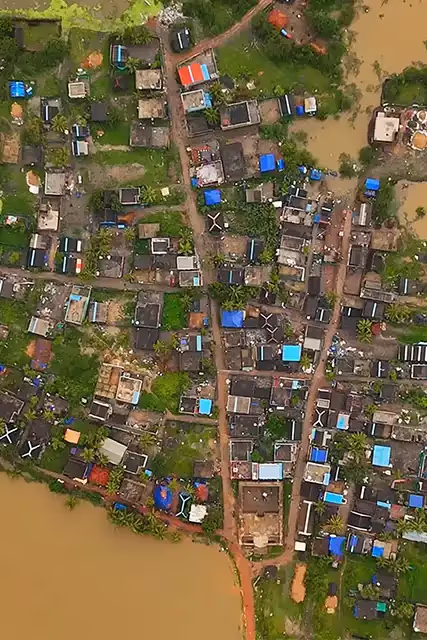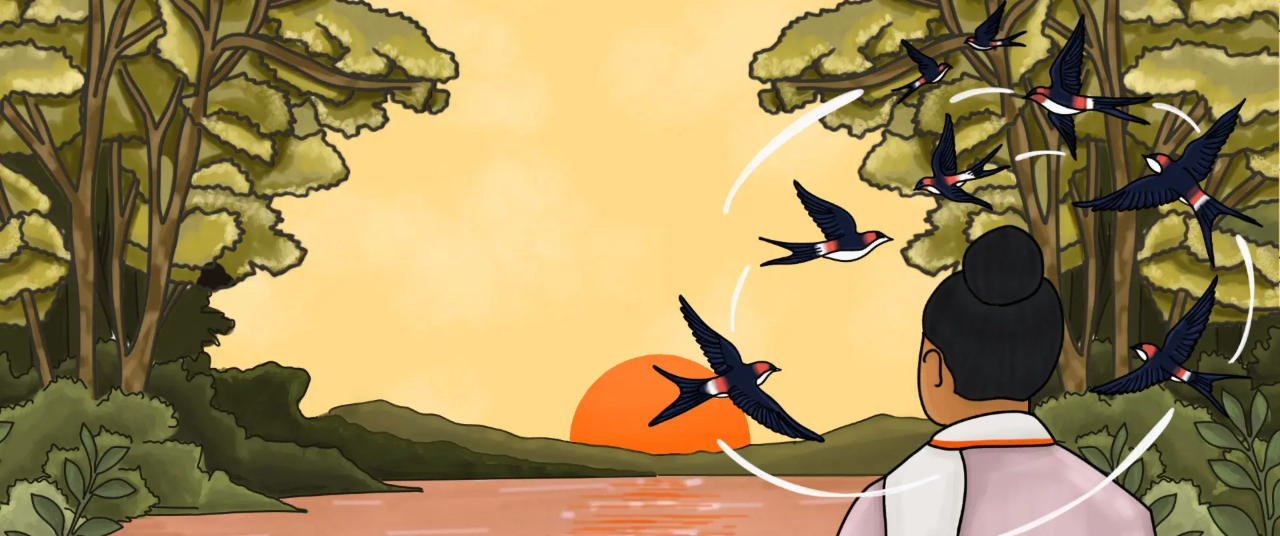Fifty years of pushing fish farming harms environment






“It felt as though the sea had come closer to our homes, flooding the villages, roads, and farms. No one expected the water to reach this far — all the way to the Eluru-Vijayawada road, part of National Highway 5 (NH-5)," said Gantasala Peddiraju, a 58-year-old aquaculture farmer.
Peddiraju lives in one of the 46 island villages within Kolleru Lake, the largest freshwater body in India and a designated RAMSAR site.
On September 6, the lake's water levels rose to 12 feet, with dangerous inflows of 25,000 to 30,000 cusecs from the upstream channels of Budameru, Ramileru, Tammileru, and Munneru.

Kolleru Lake has a natural capacity of only 10,000 cusecs and relies on a single outlet — the Upputeru channel — which connects the lake to the Bay of Bengal, flowing 63 kilometres through low-lying plains until it meets the sea.
For over a week, villagers were cut off and had to stay in temporary shelters arranged by the Andhra Pradesh government.
What haunts Peddiraju and many other aquaculture farmers is their loss: fish worth crores escaped into Kolleru Lake and ultimately the ocean, never to return. “Farmers who lost their livestock and paddy in the floods received compensation, as did those whose homes were submerged. But no one cared about us,” said Peddiraju.
According to Nagalingachari, deputy director of the fisheries department, fishing within the 5-contour line of Kolleru Lake is illegal as the area is a designated wildlife sanctuary. Because these operations are illegal, they cannot receive compensation. Only six small fish tanks outside the 5-contour area have applied for and are eligible for compensation.

The question of what separates legal from illegal activities, and why aquaculture and shrimp farmers in the Kolleru Lake area cannot claim compensation, takes us back 50 years to the start of the Blue Revolution, which prioritised aquaculture at the expense of the environment.
The rise of aquaculture
Around 50 years ago, Peddiraju's family and others stood up against the Andhra Pradesh government's plan to switch from traditional farming to aquaculture as part of the Blue Revolution.
Kolleru Lake, a naturally formed wetland between the Godavari and Krishna river basins, serves as an irrigation source for farmers in 122 villages surrounding the sanctuary area (46 bed villages and 76 belt villages). Over three lakh people depend on this vital water body for their livelihoods.
The lake spans 225,250 acres up to the +10 ft contour line, while the Kolleru Wildlife Sanctuary, located within the +5 ft contour, covers 77,138 acres. Extending up to 20 kilometres around the lake, it functions as a bird sanctuary, providing habitat for over 189 species of birds, including painted storks, pelicans, and several rare and endangered species migrating from Eurasia.
The region’s high demand for fish, government subsidies, and the lake's naturally favourable conditions have transformed the fortunes of many locals. “Almost 98% of the carp culture in the state is developed in and around Kolleru Lake, which extends between the West Godavari and Krishna districts and is now recognised as the fish bowl of India,” stated a 2007 study.
However, this economic boom has taken a toll on the lake’s environmental health. By 2006, illegal fishing ponds had spread across the lake, with 1,776 tanks (1,140 in West Godavari and 636 in Krishna district) covering around 43,724 acres. These structures, both in and around Kolleru, have disrupted the lake’s natural habitat and altered its ecosystem.

Due to these concerns, the state government initiated Operation Kolleru in 2006 based on Supreme Court orders. “While the Supreme Court judgement called for rehabilitating aquaculture farmers before evicting them, the state government did not do so,” said Peddiraju.
Dr Tallavajhula Patanjali Sastri, who has fought a legal case to restore the lake for many years, described the entire eviction process as unscientific. He explained that instead of educating villagers about the Supreme Court’s orders, officials used explosives to destroy illegal fish ponds. “This made the villagers so angry that I was told not to visit the lake alone because of my involvement in the case. The village leaders are also using 'veli' (ostracism) to stop people from supporting our efforts to restore the lake,” Sastri added.
He also pointed out that evictions have only worsened the situation, with fish ponds in the sanctuary area now averaging between 50 and 100 acres. In a recent complaint to the NGT, Sastri noted that about 18,000 acres of the 77,138-acre sanctuary have been taken over by the construction of fish ponds, buildings and roads.
Political will
A recent report from the Ministry of Statistics and Programme Implementation (MOSPI) showed that Andhra Pradesh has the largest share of India's fishing and aquaculture sector, accounting for 40.9%. BV Seshagiri Rao, an environmental activist and former zoology lecturer at DNR College in Bhimavaram, pointed out that aquaculture around Kolleru Lake plays a significant role in this sector.
According to G.O.Ms.No.120 from October 4, 1999, a high court decision from July 30, 2001, and the Supreme Court's orders from April 2006, landowners can practise traditional farming without using pesticides or chemicals.
Turning land into fish ponds by building structures and using chemicals is harming the natural flow of water and affecting water quality. Politicians tend to prioritise profit over the environment. The local population of about three lakh villagers represents many votes, and the money made from the fish economy influences politics, making it less likely for politicians to follow environmental guidelines, he added.
Rao argued that while some villagers benefit, it’s misleading to think aquaculture has helped poor farmers. In reality, it mostly benefits wealthier farmers who act on behalf of others. Further, there is no formal evidence to support this, as most leasing agreements were made verbally in front of village elders.
The former principal secretary of the Andhra Pradesh government’s Environment, Forests, Science, and Technology Department expressed similar concerns to the Central Empowered Committee (CEC) set up by the Supreme Court in 2006. He stated that the rich and powerful have taken over commercial activities under the pretence of supporting the livelihoods of the poor. Instead of working to restore the lake to its former beauty, a significant resolution was passed in the Andhra Pradesh Legislative Assembly on September 4, 2008, during the Congress government.
The resolution urged the National Board of Wildlife, Government of India, and the Central Empowered Committee to reduce the boundary of the Kolleru Wildlife Sanctuary from the +5' contour (77,138 acres) to the +3' contour (33,750 acres) to address challenges faced by local farmers.
In response, the Government of India constituted a seven-member committee headed by Dr PA Azeez of the Salim Ali Centre for Ornithology and Natural History (SACON). However, the committee did not support the proposed reduction, as it would severely impact wildlife conservation, particularly the protection of migratory birds.
Despite this, efforts to reduce the sanctuary's size were revived under the NDA government led by TDP chief and then chief minister N Chandrababu Naidu. On December 23, 2014, the Andhra Pradesh Legislative Assembly passed a similar resolution to reduce the sanctuary’s boundaries.
The resolution stated that the state could not provide compensation for acquiring private lands and relocating affected families. Farmers claimed losses due to restrictions on chemical use. At this time, the union government stated that Compensatory Afforestation Management & Planning Agency (CAMPA) funds could not be used for acquiring private lands.
The Standing Committee subsequently formed a Working Group chaired by Prof R Sukumar, a representative from the Wildlife Institute of India, whose expertise lies mainly in elephant ecology and tropical forest ecology, not wetlands.
Although the Sukumar Committee also rejected the proposal to reduce the sanctuary’s size, it recommended the denotification of nearly 15,000 acres of Zeroyiti (private) lands and an additional 5,600 acres of D-pattas for aquaculture farming within the wildlife reserve.
“This undermined the entire argument for maintaining the free flow of water and the ecological health of Kolleru Lake, as it provides a backdoor entry,” said Sastri, who has challenged these recommendations.
Uncertain future
“Illegal farms do exist. This time, not just the low-lying areas or those in reserve areas have been affected; even the highway has been flooded. There are hundreds of legal farms adhering to environmental norms. Our losses run into crores. Isn’t it the government’s duty to compensate us?” asked J. Ramarao, a 73-year-old aquaculture farmer.
“The lake’s water is no longer suitable for agriculture. Sewer channels from many districts mix in Kolleru before draining into the Bay of Bengal,” he added.
Within the lake area, it is estimated that around 18,100 tons of chemical fertilisers and 1,600 tons of pesticides are used each year, with their residues flowing into the lake through 15 major drains, as found by Seshagiri Rao in his study on threats to Kolleru Lake.
The aquaculture has led to poorer water quality, encroachments, human activity, and poaching, said Sastri and Rao. The lake's natural water flow allows excess or floodwater to drain safely into the ocean through its only outlet, Upputeru. Activists warned that if restoration efforts are not properly monitored, they could create challenges for the surrounding areas.
The lake’s water is no longer suitable for agriculture. Sewer channels from many districts mix in Kolleru before draining into the Bay of Bengal.
Kolleru Lake is home to birds that travel from as far away as Europe and Asia. Some birds stop for a while and can’t return, while others come here to breed. Activists have pointed out that spot-billed pelicans, which used to number in the lakhs, have now dropped to just a few thousand.

In the wake of the disaster, TDP chief, and chief minister Chandrababu Naidu, who once passed a resolution to downsize the lake, has issued a statement in the aftermath of the Budameru-induced floods in Vijayawada, acknowledging that encroachments from Vijayawada to Kolleru contributed to the floods. "The state will act tough against encroachers," Naidu said, promising stringent legislation to clear illegal settlements along the rivulets feeding into the lake.
Will this be a step toward Kolleru’s revival, or will exceptions be made for the encroachers in aquaculture farming? The answer seems uncertain.
{{quiz}}
Explore other topics
References
1. New Indian Express. (2024, September 6). Flood fury ravages Kolleru villages in Andhra Pradesh; 68 roads submerged. https://www.newindianexpress.com/states/andhra-pradesh/2024/Sep/06/flood-fury-ravages-kolleru-villages-in-andhra-pradesh-68-roads-submerged
2. Raghavan, K., & Sathya, P. (2015). Impact of Environmental Changes on Fisheries and Aquaculture in India. CiteSeerX. https://citeseerx.ist.psu.edu/document?repid=rep1&type=pdf&doi=69b585b93232aced66945eb09d1b3290da1fcbc0
3. National Green Tribunal. (2021). Report on Environmental Issues. https://greentribunal.gov.in/sites/default/files/news_updates/221_2.pdf
4. Economic Times. (2024, October 6). Andhra Pradesh rides the wave, leads India’s fishing and aquaculture sector with 41% share. https://economictimes.indiatimes.com/news/india/andhra-pradesh-rides-the-wave-leads-indias-fishing-and-aquaculture-sector-with-41-share/articleshow/111203921.cms?from=mdr
5. Indian Institute of Science. https://ces.iisc.ac.in/?q=user/28
6. Times of India. (2024, October 5). CM N. Chandrababu Naidu: Operation Budameru to remove encroachers along river. https://timesofindia.indiatimes.com/city/vijayawada/cm-n-chandrababu-naidu-operation-budameru-to-remove-encroachers-along-river/articleshow/113217961.cms





.avif)


.png)


